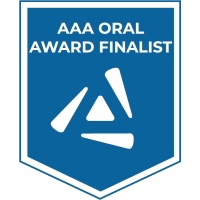Back
ANATOMY
Education
58.3 - Do Our Hands See What Our Eyes See: Investigating the Relationships Between Spatial and Haptic Abilities
Saturday, April 2, 2022
3:30 PM – 3:45 PM
Room: 103 AB - Pennsylvania Convention Center
Michelle Sveistrup (The University of Western Ontario), Jean Langlois (CIUSSS de l’Estrie – Centre Hospitalier Universitaire de Sherbrooke), Timothy Wilson (The University of Western Ontario )
-
Michelle Sveistrup
Presenting Author
The University of Western Ontario
Presenting Author(s)
Introduction: Spatial abilities (SA) are the cognitive ability to manipulate mental images of objects to problem solve and are linked to comprehension of three-dimensional (3D) spatial knowledge in gross anatomy and in learning clinical procedures. Similarly, haptic abilities (HA) refer to translating tactile information from the immediate environment into mental images and are involved in handling anatomical specimens and technical skill acquisition common to clinicians. Both abilities independently play an important role in learning anatomy, yet the relationships between SA and HA are unknown. The objective of this study is to explore SA-HA interactions.
Methods: The Mental Rotations Test (MRT) and the newly developed haptic abilities test (HAT) respectively quantified SA and HA in undergraduate students. The HAT, modelled after the MRT, consisted of untimed, matching questions utilizing MRT-styled 3D handheld wooden objects (~10cm3) under three sensory conditions using sight (S), haptics (H) and the combination of both sight and haptics (SH). While HAT condition scores and response times determined accuracy, video recorded subject gaze and haptic behaviours on a question-by-question basis. Scores for MRT are presented as mean ± SD and HAT scores as median (Q1-Q3).
Results: Subjects (n=16, 10F, 20-28yrs) completed the MRT and HAT and were categorized into high (n=9, 4F, MRT: 14.8±3) and low (n=7, 6F, MRT: 6.3±3) (H/LSA) groups (plt;0.0001). Scores obtained in the H condition [14 (13-15) vs 14 (14-14), p=0.0031] were significantly lower than in the S [15 (15-15) vs 14 (14-15)] and SH conditions [15 (15-15) vs 14 (14-15)] in H/LSA groups respectively. Spearman’s correlation coefficient illustrated MRT scores were moderately related in the S condition (r=0.506, p=0.038), but unrelated in the SH and H conditions (SH: r=0.325, p=0.203; H: r=0.162, p=0.534). The number of pupillary fixations per question was similar (S:6.0±3.0 vs 5.9±1.4, p=0.910; SH: 4.5±2.0 vs 6.7±2.0, p=0.099) for H/LSA groups respectively. Initial descriptive analyses of hand behaviours (n=4) suggest H/LSA objects differently.
Discussion: Despite significant difference in SA, when individuals are presented identical environmental 3D objects to view, view and touch, or touch alone, it is difficult to differentiate SA. These data suggest that the addition of haptic sensory information may aid LSA individuals completing spatial tasks. Although visual attention and timing of haptic behaviours may be similar between H/LSA subjects, further kinematic analysis of haptic strategies may be more meaningful to isolate how somatosensory inputs aid problem solving behaviours in LSA persons. This is some of the first data to simultaneously measure hand and gaze behaviour during spatially challenging tasks in individuals with divergent SA. Given recent migrations to online anatomy teaching and learning environments due to COVID-19, understanding learner behaviour when sensory inputs, like haptics, are removed is valuable evidence that can inform future anatomy curriculum and resource development.
Methods: The Mental Rotations Test (MRT) and the newly developed haptic abilities test (HAT) respectively quantified SA and HA in undergraduate students. The HAT, modelled after the MRT, consisted of untimed, matching questions utilizing MRT-styled 3D handheld wooden objects (~10cm3) under three sensory conditions using sight (S), haptics (H) and the combination of both sight and haptics (SH). While HAT condition scores and response times determined accuracy, video recorded subject gaze and haptic behaviours on a question-by-question basis. Scores for MRT are presented as mean ± SD and HAT scores as median (Q1-Q3).
Results: Subjects (n=16, 10F, 20-28yrs) completed the MRT and HAT and were categorized into high (n=9, 4F, MRT: 14.8±3) and low (n=7, 6F, MRT: 6.3±3) (H/LSA) groups (plt;0.0001). Scores obtained in the H condition [14 (13-15) vs 14 (14-14), p=0.0031] were significantly lower than in the S [15 (15-15) vs 14 (14-15)] and SH conditions [15 (15-15) vs 14 (14-15)] in H/LSA groups respectively. Spearman’s correlation coefficient illustrated MRT scores were moderately related in the S condition (r=0.506, p=0.038), but unrelated in the SH and H conditions (SH: r=0.325, p=0.203; H: r=0.162, p=0.534). The number of pupillary fixations per question was similar (S:6.0±3.0 vs 5.9±1.4, p=0.910; SH: 4.5±2.0 vs 6.7±2.0, p=0.099) for H/LSA groups respectively. Initial descriptive analyses of hand behaviours (n=4) suggest H/LSA objects differently.
Discussion: Despite significant difference in SA, when individuals are presented identical environmental 3D objects to view, view and touch, or touch alone, it is difficult to differentiate SA. These data suggest that the addition of haptic sensory information may aid LSA individuals completing spatial tasks. Although visual attention and timing of haptic behaviours may be similar between H/LSA subjects, further kinematic analysis of haptic strategies may be more meaningful to isolate how somatosensory inputs aid problem solving behaviours in LSA persons. This is some of the first data to simultaneously measure hand and gaze behaviour during spatially challenging tasks in individuals with divergent SA. Given recent migrations to online anatomy teaching and learning environments due to COVID-19, understanding learner behaviour when sensory inputs, like haptics, are removed is valuable evidence that can inform future anatomy curriculum and resource development.

